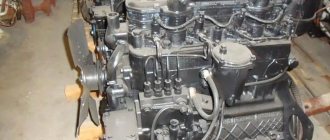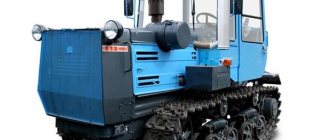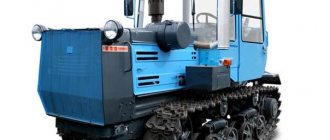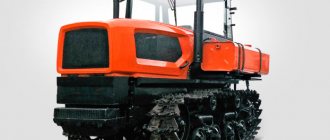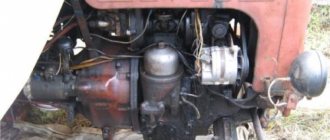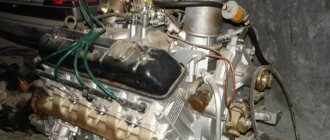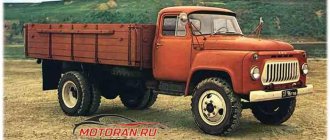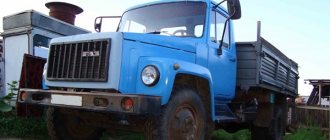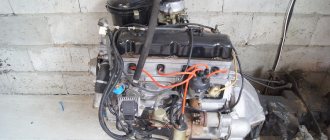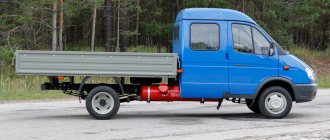The four-cylinder 4-stroke diesel engine D 240 is air-cooled and has direct fuel injection. This power unit was installed on the MTZ 80 tractor and enjoyed well-deserved love among car owners.
The reliable, maintainable, powerful and easy-to-use motor lasted on the assembly line for several decades and is also found on MTZ tractors today.
Specifications
Download .xls file
xls
Download picture
Send by email
| OPTIONS | MEANING |
| Cylinder block material | cast iron |
| Supply system | Direct injection |
| Type | in-line |
| Working volume, l | 4.75 |
| Power, l. With. | 80 |
| Number of cylinders | 4 |
| Number of valves per cylinder | 2 |
| Piston stroke, mm | 125 |
| Cylinder diameter, mm | 110 |
| Compression ratio | 16 |
| Fuel | Diesel fuel |
| Fuel consumption | No more than 238 liters per hour |
The engine was installed on the MTZ 80 tractor and its modifications.
Purpose
The review of the MTZ 82 tractor presented in the factory catalog allows us to determine that the Belarus 82 was most widely used when performing the following work:
- soil preparation (plowing, harrowing, cultivation);
- application of various fertilizers;
- processing of agricultural plants and their harvesting;
- transportation of goods;
- loading and unloading operations.
In the conditions of farms and larger agricultural enterprises, various loading and unloading operations are often required. Purchasing specialized equipment for this work is quite expensive, since it is not possible to load it all year round. Therefore, the ability to aggregate the MTZ 82 tractor with loading and unloading equipment is considered a very successful solution. This allows you to get:
- front loader on MTZ 82;
- loader-excavator for excavation work MTZ 82 with a bucket volume of up to 0.3 cubic meters. m;
- installation lift (lifting height up to 9.0 m);
- grab loader for rolls based on MTZ 82;
- MTZ 82.1 with a mounting hook, for loading and unloading piece goods.
Description
This is a classic four-cylinder modification of a diesel engine, which has a reinforced cylinder block, and thanks to the presence of air cooling, its design is significantly simplified. This naturally aspirated power unit is highly reliable and easy to maintain. Its maintainability allows repairs to be carried out even in the field.
Due to the presence of direct fuel injection, the engine provides the necessary traction and excellent power characteristics. The motor has an electric starter, which significantly simplifies the operation of the MTZ-80 tractor in the winter, when problems with starting a diesel engine could be observed.
Another design feature of this engine is an undivided combustion chamber, as well as the formation of a volume-film working mixture. In this case, the inlet of the fuel mixture into the combustion chamber is carried out as follows. Part of the fuel is sprayed into the maximum possible volume of the combustion chamber, while the other part spreads over the surface of the cylinder, creating the necessary thin film. As a result of such technologies, the maximum possible power and efficient combustion of fuel are ensured, which has improved the dynamic characteristics of this power unit.
The combustion chamber itself has an original spherical shape, which improves the mixing of air and fuel, forming vortex air flows inside the combustion chamber. The power of the D 240 engine is 80 horsepower, which is achieved at 2200 crankshaft revolutions per minute. At the same time, the engine is characterized by proper throttle response, guaranteeing the tractor the necessary power and traction.
The D 240 cylinder block was cast from high-strength gray cast iron. The use of such material allows you to completely avoid the occurrence of thermal deformations of the power unit when the engine overheats. The cylinder head is attached to the block using 16 extended studs. It should be said that the studs were tightened using a torque wrench, which must be taken into account when performing repair work.
Note that this modification of the engine used a special design of the valve mechanism, which made it possible to protect the valves in the event of a timing chain break. This increased the reliability of the engine, and the engine itself could be operated for a long time without the need for major repairs.
Tractor oil - mineral and synthetic
If necessary, a milling cutter of a technological type can be additionally attached to the tractor system of special equipment; universal small-sized working excavator of a chain version, type ECU-150; mounted type of technological trailer; a professional version of the grab loader-excavator series PE-F-1 B BM, industrial attachments in the form of a snow blower with a special rotary auger; industrial production technological rakes based on the design of the tedder; a graduated complex that crushes plant bushes and branches; as well as a full-fledged agricultural harrow. Now, as for the injectors and fuel equipment, we install modern-style injectors on the new head; the high-pressure tubes supplying fuel from the injection pump to the injectors will have to be re-bent or different ones selected.
Malfunctions
| FAULT | REMEDY METHODS |
| The engine has significantly lost power and reacts poorly to pressing the gas pedal. | The cause of such a breakdown may be the failure of the fuel pump, which does not provide the necessary pressure in the system. |
| A pronounced metallic knock appeared over a wide speed range. | We recommend opening the engine and adjusting the valves. Such service work should be carried out every 50 thousand kilometers of the engine. |
| Significant oil leaks appeared. | Engine oil can leak either from under the valve cover or through an oil filter that has lost its seal. It is necessary to localize the location of the leak and, depending on its location, carry out appropriate repairs. |
| The motor vibrates a lot. | Check the condition of the engine mounts, which are the weak point of this engine. If there is a problem with such pillows, the motor must be replaced. |
Engine cooling system D-240 Cooling system
7 Interaction of lubrication system devices D-240 1 oil intake; 2 pump; 3 safety valve; 4 centifuga; 5 radiator; 6 pressure gauge indicator; 7 drain valve; 8 radiator thermostat valve; KnSh main and connecting rod bearings; P camshaft support; PN and PN gears of the fuel pump drive and intermediate VK rocker arm bushings. Ground clearance, mm 450 Between the wheel axles front and rear, m 3 Front track, m 2-2.15 Rear track, m 2.13-2.63 Maximum speed forward backward, km h 40 20.8 Minimum speed forward reverse, km h 0.34 0.43 Minimum turning radius, m 6.5 Fuel tank volume, l 650 Front tire size 600 65R34 Rear tire size 710 70R42 Exerted ground pressure, kPa 180 Maximum fording depth, m 0.8.
| Message |
Tuning
It is possible to increase the power of the power unit to about 100 horsepower by installing a turbine and a new fuel supply system on the D 240 engines.
In specialized stores you can find a ready-made conversion kit for a turbine, which includes the necessary fasteners, the turbocharger itself, a new oil and fuel pump. Such tuning will significantly increase the power of the power unit with virtually no loss of engine reliability.
How to calculate real gas mileage #1 auto tips
The basic model of the Belarus MTZ 3522 tractor is equipped with a four-stroke diesel engine with six cylinders, model TCD2013L 064V C3UT261, manufactured by Deutz in Germany. Engine diagram D-240 1 flywheel; 2 breather; 3 cylinder head gasket; 4 cylinder head; 5 cylinder head cover; 6 rocker shaft; 7 valve spring plate; 8 exhaust valve; 9 suction valve; 10 valve spring; 11 rocker shaft support; 12 valve rocker arm; 13 cover cap; 14 rod; 15 cylinder block; 16 valve tappet; 17 distribution board; 18 distribution cover; 19 adjusting bolt; 20 shock absorber with limiter; 21 front engine mounts; 22 cuff; 23 oil pump drive gear; 24 crankshaft camshaft gear; 25 timing gear; 26 camshaft; 27 crankshaft; 28 connecting rod; 29 counterweight; 30 piston pin; 31 piston; 32 sealing ring of the sleeve; 33 oil pan; 34 cuff; 35 cylinder liner; 36 back sheet; 37 bushing.
Engine compression: measurement results (table of total values)
Good afternoon, in today’s article we will tell you about checking the compression of a car engine. In this article we will talk about how to correctly measure the compression of an internal combustion engine, consider what indicators of this procedure there are and how the final result affects the calculation of a particular problem with the engine. In addition, we will clearly see a table with the final results of compression and signs of malfunction of one or another indicator, which reflects a specific malfunction in the device.
You can often hear from friends and relatives that the engine in a car was working perfectly and suddenly it began to lose power, fuel and oil consumption increased, and you can also feel excessive vibration at idle. To unambiguously determine what is happening to the heart of the car and what possible malfunctions have occurred with it, they use the method of measuring internal combustion engine compression. This procedure can be performed at specialized service stations or at home using a special device for measuring compression called a compression meter.
So, let's begin to consider the topic of accuracy and correctness of measuring engine compression, as well as identifying internal combustion engine faults based on the measurement results.
1. The concept of compression of an internal combustion engine
– this is an indicator of the highest pressure in the working area of the cylinder, which is formed when the engine is idling with the starter turning and the spark plugs disconnected. Engine compression is very often compared with the compression ratio parameter; note that these are completely different measurements and indicators.
To measure compression, as a rule, unscrew all the spark plugs and connect a special device called a compression meter, which resembles a device such as a pressure gauge for measuring tire pressure.
. The compression tester consists of a connecting hose with a threaded end and a back pressure valve. When the crankshaft moves, air is pumped into the connecting hose to such a level until the pressure in the hose itself becomes the same as in the working area of the cylinder. An indicator that will be at the maximum level and will be reflected by the compressometer device on its scale.
Checking and adjusting the valve clearances of the D-243 engine Cooling system
To carry out the most accurate calculations, a special formula is used, which, however, is equally relevant not only for MTZ 80 tractors, but also for all other types of equipment, both agricultural and other. This makes it necessary to apply a coefficient that would take into account the ratio of the engine operating time at high speeds to the engine operating time at minimum speeds.
| Overall dimensions, mm: | ||
| length (at ends of longitudinal rods) | 3815 | 3930 |
| width (at the protruding ends of the rear wheel axle shafts) | 1970 | |
| height: | ||
| by cladding | 1615 | 1665 |
| around the cabin | 2470 | |
| Longitudinal base, mm | 2370 | 2450 |
| Track, mm: | ||
| on the front wheels | 1200-1800 | 1300-1800 |
| on the rear wheels | 1350-2100 | |
| Ground clearance, mm: | ||
| under the rear axle axle sleeves | 650 | |
| under the front axle | 650 | – |
| under the sleeves of the front axle axle shafts | – | 650 |
| under the rear axle | 470 | |
| under the front axle housing | – | 590 |
| Turning radius in the middle of the track of the outer front wheel with a track of 1400 mm with braking of the inner rear wheel, m | 4,1 | 4,3 |
| Structural weight (with cabin, but without additional equipment and ballast weights), kg | 3160 | 3270 |
| Maximum weight of towed trailer, kg | 12000 | 12000 |
| Maximum weight of the implement mounted at the rear when installing additional weights on the front beam, kg | 900 | 900 |
| Angles of ascent (descent) without a trailer, degrees | 20 | 20 |
| Fording depth, m | 0,85 | 0,85 |
Gas distribution mechanism
The gas distribution mechanism includes a camshaft, intake and exhaust valves, as well as parts for their installation and drive: pushers, rods, rocker arms, adjusting screws with nuts, plates with crackers, springs, struts, rocker arm axles.
The camshaft is a three-bearing one, driven from the crankshaft through the timing gear. The camshaft bearings are 3 bushings, which are pressed into the block bores.
The front bushing (from the fan side) is made of aluminum alloy, has a thrust collar that holds the camshaft from axial movement, the remaining bushings are cast iron. The pushers are steel. The working surface of the pusher plate is overlaid with bleached cast iron and has a spherical surface of large radius (750 mm). As a result of the fact that the camshaft cams are made with a small cone, the tappets perform a rotational movement during operation.
The push rods are made of steel rod. The spherical part that fits inside the pusher and the rod cup are hardened. The valve rocker arms are steel, swinging on an axis mounted on 4 racks. The outer pillars have increased rigidity. The rocker arm axis is hollow, having 8 radial holes for lubrication of the rocker arms. The movement of the rocker arms along the axis is limited by spacer springs.
The intake and exhaust valves are made of heat-resistant steel. They move in guide bushings that are pressed into the cylinder head. Each valve closes under the influence of 2 springs: external and internal, which act on the valve through a plate and crackers.
The sealing collars, which are installed on the valve guides, prevent oil from entering the engine cylinders and exhaust manifold through the gaps between the valve stems and the valve guides.
Cylinder block
The cylinder block is the main body part of a diesel engine, a rigid cast iron. In the vertical borings of the BC there are 4 removable sleeves made of special cast iron.
The liner is installed in the cylinder block along two centering belts: upper and lower. In the upper belt the sleeve is secured with a collar, and in the lower belt it is sealed with 2 rubber rings.
Coolant circulates between the walls of the cylinder block and the liners.
The end walls and transverse partitions of the BC are equipped with bosses to form crankshaft supports. Covers are installed on these tides. The bosses together with the covers form beds for the main bearings.
The cylinder block has a longitudinal channel, from which oil flows through transverse channels to the crankshaft main bearings and camshaft bearings. On the outer surfaces of the BC there are machined mating surfaces for attaching a centrifugal oil filter, water pump, coarse and fine fuel filters, and oil filler neck.
History of the creation and development of the fourth generation of GAZ cars (4x2)[edit]
In the early 80s, when developing the design of the GAZ-3307 truck and other fourth-generation models, broad unification of components and assemblies of existing production vehicles was envisaged (the chassis and carburetor power plant, in fact, were transferred from the GAZ-53-12 model), which made it possible reduce the cost of cars and at the same time facilitate their maintenance, repair and operation. The car received a more spacious modern double cabin, equipped with an effective ventilation and heating system, first used on the experimental GAZ-4301 truck in 1984. The steering design, unlike its predecessors, includes power steering for the first time. Serial production of a 4.5-ton GAZ-3307 (4x2) truck with a ZMZ-511 carburetor engine with a power of 125 hp. started at the end of 1990.
In 1992, GAZ launched serial production of the 5-ton GAZ-4301 truck with a 6-cylinder air-cooled diesel engine GAZ-542 with a power of 125 hp, produced under license from the German company Deutz, as well as the GAZ-SAZ-4509 agricultural dump truck at its chassis for operation as part of an 8.6-ton GAZ-6008 dump truck (GAZ-4509 dump truck + GKB-8536 trailer). Despite significant design differences, for example, the wheels of models 3307 and 4301 are not interchangeable, but the cars are almost identical in appearance. Production of the GAZ-4301 continued until 1995. A total of 28,158 trucks of the GAZ-4301 family were produced.
In 1993, production of a replacement for the GAZ-52 model was launched - a 3-ton truck GAZ-3306 with a 4-cylinder air-cooled diesel engine GAZ-544 with a power of 85 hp. According to some reports, in 1992, a 2.5-ton modification 33061 with a carburetor engine from the GAZ-52 was produced in a limited edition. Production of the three-ton GAZ-3306 (mainly in the “Cargo Taxi” version) continued until 1995.
At the end of 1994, with the development at GAZ of the production of a four-cylinder air-cooled turbodiesel GAZ-5441 with a power of 115 hp. The GAZ-3309 model with a lifting capacity of 4.5 tons appeared, completely unified in the chassis and cabin with the GAZ-3307 (externally it differs only in the engine air intake pipe on the left side of the cabin). By mid-1996, it completely replaced the carburetor truck 3307 from the assembly line. In mid-1997, GAZ’s own production of diesel “air vents” was considered economically unfeasible, as a result of which the production of the 3309 model was suspended until the end of 2001, and the carburetor 4 was restored to production. 5-ton GAZ-3307. Subsequently, GAZ reoriented itself to the purchase of Belarusian diesel engines MMZ D-245.7 (a similar water-cooled turbodiesel is installed on the ZIL-5301 “Bychok”) from the Minsk Motor Plant (MMZ), which began to be installed on the model 3309, which was resumed in production.
Since 1999, as part of the 4th family of GAZ trucks, the all-wheel drive (4x4) vehicle GAZ-3308 “Sadko” has been mass-produced in military (carrying capacity 2 tons) and civilian (2.3 tons) versions.
Since 2006, the GAZ-3307, GAZ-3309 and GAZ-3308 have been equipped with gasoline and diesel engines certified to Euro-2 environmental standards, and since 2008 - Euro-3. Large-scale production of models 3307 and 3308 with ZMZ gasoline engines was actually discontinued in 2009, but for some time their limited production continued for special versions certified for government agencies (for example, in 2010, 406 units of GAZ-3307 were produced). The carburetor model 3307 also continues to be exported, for example, to Belarus, where it is equipped with gas equipment. In 2010-2012 medium-tonnage GAZ trucks (4x2) were equipped primarily with the MMZ D-245.7 E-3 diesel engine (model 3309), and all-wheel drive (4x4) models 33081 “Sadko” and 33086 “Zemlyak” were equipped with the MMZ D-245.7 E-2 diesel engine. Since 2013, all 4th generation GAZ trucks for civilian use have received the MMZ D-245.7 E-4 turbodiesel with a power of 119 hp as the base engine.
Since 2012, a modification of the GAZ-33096 with a Cummins ISF 3.8L diesel engine, similar to that used on the GAZ-3310 Valdai truck, has been produced to order. Since 2013, the engine has been certified for Euro 4.
In February 2013, a modification of the GAZ-33098 with a new Russian-made diesel engine, the YaMZ-5342.10 Euro-4 class, went into production, as well as a new version of the GAZ-33088 “Sadko” all-terrain truck with a similar YaMZ-5344 engine of the EEC-96 class.
A van on a GAZ-33091 chassis with a long wheelbase.
Long-wheelbase "Dobrynya" with tuning cabin trim and sleeping compartment.
Fuel consumption rate GAZ Sobol
| GAZ Sobol Business | Fuel consumption, l/100 km |
| GAZ-22171 “Sobol” minibus with a high roof, 6+1 seats. | 11,2 |
| GAZ-2310 "Sobol" manufactured goods van, 3 seats. | 12,1 |
| GAZ-2310 “Sobol” flatbed with awning, 3 seats. | 12,1 |
| GAZ-2217 “Sobol” minibus with a low roof, 6+1 seats. | 13,2 |
| GAZ-2310 “Sobol” Europlatform, 3 seats. | 10,8 |
| GAZ-23107 “Sable 4x4” flatbed with awning, 3 seats. | 12,5 |
| GAZ-2310 “Sobol” isothermal van, 3 seats. | 12,6 |
| GAZ-231073 “Sable 4x4 Farmer” flatbed platform with awning, 6 seats. | 11,7 |
| GAZ-2217 “Sobol” transformable salon “RIVIERA” | 13,2 |
| GAZ-2752 “Sobol” all-metal van, 3 seats. | 13,2 |
| GAZ-2752 “Sobol” all-metal van, 7 seats. | 12,8 |
| GAZ-2310 “Sobol” refrigerator (sandwich), 3 seats. | 12,4 |
| GAZ-27527 “Sobol 4x4” all-metal van, 7 seats. | 12,3 |
| GAZ-22177 “Sobol 4x4” minibus with a low roof, 6+1 seats. | 12,9 |
GAZ trucks up to 2008
| Model | Fuel consumption rate per 100 km | Type of fuel |
| GAZ-2310 “Sobol” (ZMZ-40522-4L-2,464-145-5M) | 14,7 | B |
| GAZ-2704 “Farmer” g/p (GAZ-560-4L-2,134-95-5M) | 11,9 | D |
| GAZ-2943 “Farmer” (ZMZ-402-4L-2,445-100-4M) | 16,7 | B |
| GAZ-3302 (ZMZ-405220-4L-2,464-145-5M) | 15,3 | B |
| GAZ-3302 "Gazelle" (ZMZ-4063.10-4L-2.3-110-5M) | 15,5 | B |
| GAZ-3302, -33021 “Gazelle” (ZMZ-4025.10-4L-2,445-90-5M) | 16,5 | B |
| GAZ-3302, -330210 “Gazelle” (ZMZ-4026.10-4L-2,448- 100-4M) | 16,5 | B |
| GAZ-33021 (ZMZ-4025.10-4L-2,445-90-4M) | 16,9 | B |
| GAZ-33021 (UMZ-42150-4L-2.89-89-5M) | 16,6 | B |
| GAZ-330210 "Gazelle" (ZMZ-4026.10-4L-2,448-100-5M) | 16,0 | B |
| GAZ-33023-16 (6 seats) (ZMZ-4026.10-4L-2,445-100-5M) | 15,7 | B |
| GAZ-33027 "Gazelle" (ZMZ-4026.10-4L-2,445-100-5M) | 17,0 | B |
| GAZ-3307 | 24,5 | B |
| GAZ-33073 (ZMZ-511.10-8V-4.25-125-4M) | 24,9 | B |
| GAZ-3309 (GAZ-5441.10-4L-4,15-116-5M) | 17,0 | D |
| GAZ-33104 "Valdai" (D-245.7E2-4L-4.75-117-5M) | 17,3 | D |
| GAZ-52, GAZ-52A | 22,0 | B |
| GAZ-52-01 | 22,0 | B |
| GAZ-52-03 | 22,1 | B |
| GAZ-52-04 | 22,2 | B |
| GAZ-52-05 | 22,3 | B |
| GAZ-52-07, -52-08, -52-09 GAZ-52-27, -52-28 | 30,0 21 | CIS LNG |
| GAZ-53, -53A, -53-12, -53-12-016, -53-12A, -53-50, -53-70 | 25,0 | B |
| GAZ-53-07, -53-19 | 37,0 | CIS |
| GAZ-53-27 | 25,5 (25) | LNG |
| GAZ-63, -63A | 26,0 | B |
| GAZ-66, -66A, -66AE, -66E, -66-01, -66-02, -66-04, -66-05, -66-11 | 28,0 | B |
Suspension GAZ-4301
The GAZ-4301 uses a front suspension on two longitudinal semi-elliptic springs, with an additional rubber compression spring. The rear suspension is based on two longitudinal semi-elliptical springs with additional metal springs and shock absorbers. The shock absorbers on the front axle are hydraulic, telescopic, double-acting. To increase the energy capacity of the springs and limit their deflection, rubber compression springs are installed on the frame side member in the area of the front axle. Rubber buffers are also installed on the lower flange of the rear frame side members, above the rear axle, to limit the degree of spring deflection.

